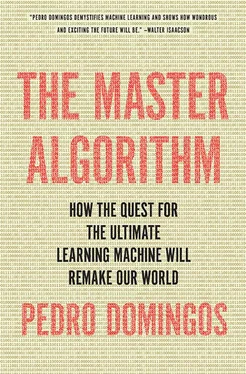Newton’s principle is only the first step, however. We still need to figure out what is true of everything we’ve seen-how to extract the regularities from the raw data. The standard solution is to assume we know the form of the truth, and the learner’s job is to flesh it out. For example, in the dating problem you could assume that your friend’s answer is determined by a single factor, in which case learning just consists of checking each known factor (day of week, type of date, weather, and TV programming) to see if it correctly predicts her answer every time. The problem, of course, is that none of them do! You gambled and failed. So you relax your assumptions a bit. What if your friend’s answer is determined by a conjunction of two factors? With four factors, each with two possible values, there are twenty-four possibilities to check (six pairs of factors to pick from times two choices for each factor’s value). Now we have an embarrassment of riches: four conjunctions of two factors correctly predict the outcome! What to do? If you’re feeling lucky, you can just pick one of them and hope for the best. A more sensible option, though, is democracy: let them vote, and pick the winning prediction.
If all conjunctions of two factors fail, you can try all conjunctions of any number of factors. Machine learners and psychologists call these “conjunctive concepts.” Dictionary definitions are conjunctive concepts: a chair has a seat and a back and some number of legs. Remove any of these and it’s no longer a chair. A conjunctive concept is what Tolstoy had in mind when he wrote the opening sentence of Anna Karenina : “All happy families are alike; each unhappy family is unhappy in its own way.” The same is true of individuals. To be happy, you need health, love, friends, money, a job you like, and so on. Take any of these away, and misery ensues.
In machine learning, examples of a concept are called positive examples, and counterexamples are called negative examples. If you’re trying to learn to recognize cats in images, images of cats are positive examples and images of dogs are negative ones. If you compiled a database of families from the world’s literature, the Karenins would be a negative example of a happy family, and there would be precious few positive examples.
Starting with restrictive assumptions and gradually relaxing them if they fail to explain the data is typical of machine learning, and the process is usually carried out automatically by the learner, without any help from you. First, it tries all single factors, then all conjunctions of two factors, then all conjunctions of three, and so on. But now we run into a problem: there are a lot of conjunctive concepts and not enough time to try them all out.
The dating example is a little deceptive because it’s very small (four variables and four examples). But suppose now that you run an online dating service and you need to figure out which couples to match. If each user of your system has filled out a questionnaire with answers to fifty yes/no questions, each potential match is characterized by one hundred attributes, fifty from each member of the prospective couple. Based on the couples that have gone on a date and reported the outcome, can you find a conjunctive definition for the concept of a “good match”? There are 3 100possible definitions to try. (The three options for each attribute are yes, no, and not part of the concept.) Even with the fastest computer in the world, the couples will all be long gone-and your company bankrupt-by the time you’re done, unless you’re lucky and a very short definition hits the jackpot. So many rules, so little time. We need to do something smarter.
Here’s one way. Suspend your disbelief and start by assuming that all matches are good. Then try excluding all matches that don’t have some attribute. Repeat this for each attribute, and choose the one that excludes the most bad matches and the fewest good ones. Your definition now looks something like, say, “It’s a good match only if he’s outgoing.” Now try adding every other attribute to that in turn, and choose the one that excludes the most remaining bad matches and fewest remaining good ones. Perhaps the definition is now “It’s a good match only if he’s outgoing and so is she.” Try adding a third attribute to those two, and so on. Once you’ve excluded all the bad matches, you’re done: you have a definition of the concept that includes all the positive examples and excludes all the negative ones. For example: “A couple is a good match only if they’re both outgoing, he’s a dog person, and she’s not a cat person.” You can now throw away the data and keep only this definition, since it encapsulates all that’s relevant for your purposes. This algorithm is guaranteed to finish in a reasonable amount of time, and it’s also the first actual learner we meet in this book!
How to rule the world
Conjunctive concepts don’t get you very far, though. The problem is that, as Rudyard Kipling said, “There are nine and sixty ways of constructing tribal lays, and every one of them is right.” Real concepts are disjunctive. Chairs can have four legs or one, and sometimes none. You can win at chess in countless different ways. E-mails containing the word Viagra are probably spam, but so are e-mails containing “FREE!!!” Besides, all rules have exceptions. Some families manage to be dysfunctional yet happy. Birds fly, unless they’re penguins, ostriches, cassowaries, or kiwis (or they’ve broken a wing, or are locked in a cage, or…).
What we need is to learn concepts that are defined by a set of rules, not just a single rule, such as:
If you liked Star Wars, episodes IV-VI, you’ll like Avatar.
If you liked Star Trek: The Next Generation and Titanic, you’ll like Avatar.
If you’re a member of the Sierra Club and read science-fiction books, you’ll like Avatar.
Or:
If your credit card was used in China, Canada, and Nigeria yesterday, it was stolen.
If your credit card was used twice after 11:00 p.m. on a weekday, it was stolen.
If your credit card was used to purchase one dollar of gas, it was stolen.
(If you’re wondering about the last rule, credit-card thieves used to routinely buy one dollar of gas to check that a stolen credit card was good before data miners caught on to the tactic.)
We can learn sets of rules like this one rule at a time, using the algorithm we saw before for learning conjunctive concepts. After we learn each rule, we discard the positive examples that it accounts for, so the next rule tries to account for as many of the remaining positive examples as possible, and so on until all are accounted for. It’s an example of “divide and conquer,” the oldest strategy in the scientist’s playbook. We can also improve the algorithm for finding a single rule by keeping some number n of hypotheses around, not just one, and at each step extending all of them in all possible ways and keeping the n best results.
Discovering rules in this way was the brainchild of Ryszard Michalski, a Polish computer scientist. Michalski’s hometown of Kalusz was successively part of Poland, Russia, Germany, and Ukraine, which may have left him more attuned than most to disjunctive concepts. After immigrating to the United States in 1970, he went on to found the symbolist school of machine learning, along with Tom Mitchell and Jaime Carbonell. He had an imperious personality. If you gave a talk at a machine-learning conference, the odds were good that at the end he’d raise his hand to point out that you had just rediscovered one of his old ideas.
Sets of rules are popular with retailers who are deciding which goods to stock. Typically, they use a more exhaustive approach than “divide and conquer,” looking for all rules that strongly predict the purchase of each item. Walmart was a pioneer in this area. One of their early findings was that if you buy diapers you are also likely to buy beer. Huh? One interpretation of this is that Mom sends Dad to the supermarket to buy diapers, and as emotional compensation, Dad buys a case of beer to go with them. Knowing this, the supermarket can now sell more beer by putting it next to the diapers, which would never have occurred to it without rule mining. The “beer and diapers” rule has acquired legendary status among data miners (although some claim the legend is of the urban variety). Either way, it’s a long way from the digital circuit design problems Michalski had in mind when he first started thinking about rule induction in the 1960s. When you invent a new learning algorithm, you can’t even begin to imagine all the things it will be used for.
Читать дальше












